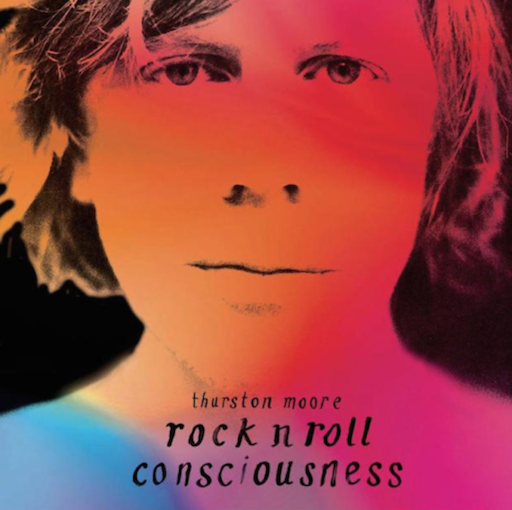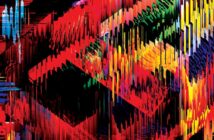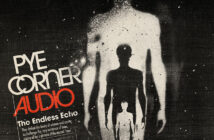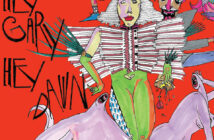Thurston Moore announced the title of this album while he was playing his gig at Sydney’s Metro in December 2015, so it’s obviously been in place for quite some time. In fact it was recorded at the end of 2015, but Moore has been hanging on to it because ‘I didn’t want the record to come out in a year of political campaigning in the USA, because it was so contentious. It was so heinous that I was like “I don’t even want to be active in a culture that’s overwhelmed by this inanity.”’ The rather ponderous title was influenced by a stint of teaching he did at the Summer Writing Program at the Jack Kerouac School of Disembodied Poetics at Naropa University in Boulder, Colorado, a school started by poets Allen Ginsberg and Anne Waldman. He has been teaching there for the past six years, and the expression ‘rock n roll consciousness’ came about in relation to his culture as a musician and a frequenter of record shops. His previous album The Best Day with his new band (guitarist James Sedwards from his house in London, former Sonic Youth drummer Steve Shelley, and My Bloody Valentine bassist Deb Goodge) was basically created in the studio from scratch, but excellent just the same, and they have road tested it extensively since. As he has said, ‘It was made just finding out what people sounded like, and there were some songs on the record that were just me playing acoustic guitars and everything on the track, so it’s a bit of a pastiche’.
It also included the instrumental track, Grace Lake, based on the nom de plume of former Angry Brigade member Anna Mendelssohn, a poet, painter, actress and musician, and one of the Stoke Newington Eight, who were accused of conspiracy to cause explosions in the longest criminal trail at that point in English legal history (in 1972), regularly serialised at the time in Time Out. After giving an impassioned defence of herself, she received a ten year sentence, of which she served five. She later devoted herself to poetry and art, and also had three children, becoming a virtual recluse after being quietly released in 1976. She left a legacy of several thousand poems and pen and ink drawings, and died of a brain tumour in 2009. Her poetry was published mainly due to the efforts of friends, whom Moore came to know in London, and who included the transsexual poet Radio Radieux, who contributed lyrics to three tracks on The Best Day, including ‘Detonation’, a history of radicalism in London in the early 1970s. (The Angry Brigade also appear in Jake Arnott’s 2006 novel Johnny Come Home, which also features a character based on Gary Glitter). As Moore has commented: ‘It was a gender balanced radical group of women and men who took it upon themselves to put the ideas of anarchism they were reading about into play in the face of this imbalance of power that they saw in London. A police station and a fashion house were bombed, but nobody was hurt. They weren’t about hurting people, it was about making explosive commentary. They all got busted and thrown in jail, and it changed a lot of their lives forever’.
Radio Radieux also contributes lyrics to Rock n Roll Consciousness, in fact the first words heard after a lengthy guitar introduction to the first track, ‘Exalted’, which comes in at 11minutes 50 seconds, come from Radieux: ‘She is the Future and the Prophetess’. The second track, ‘Cusp’ is 6 minutes 34 seconds, the third, ‘Turn On’ is 10:18, ‘Smoke of Dreams’ is 6:05 and ‘Aphrodite’ is 8:08. Pop producer Paul Epworth, who has worked with Adele and Florence and the Machine, was an odd choice, but it has worked out well, especially as his studio the Church was so congenial (and close to home). ‘Shred’ seems to be the operative word on the album, as there is extensive guitar shredding over just five tracks: ‘I wrote the songs knowing who the musicians were, that’s why the songs are so lengthy because I really wanted these musicians to play. I really wanted James Sedwards to shred on guitar … and also for Deb and Steve to really get their feet wet’. If the result comes out sounding a lot like Sonic Youth in their best moments that is not at all detrimental – it’s the sound of four musicians playing at peak power, and Moore has commented that the mental communication between them is similar to that which existed between Sonic Youth. When I saw Sonic Youth support Sun Ra live in Central Park, New York, in July, 1992, they opened with ‘Teenage Riot’ and got a message back that they could be heard in Park Avenue. This time they’re aiming for Trump Tower – ‘it’s a token of promise and springtime and new energy, like “Let’s get up there and gather our amplifiers and surround Trump Tower and blast them as loud as we can with noise and stuff until it crumbles into the fake gold dust that it is”’. I can’t wait to hear this one live.




